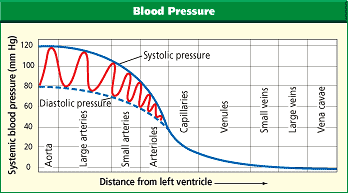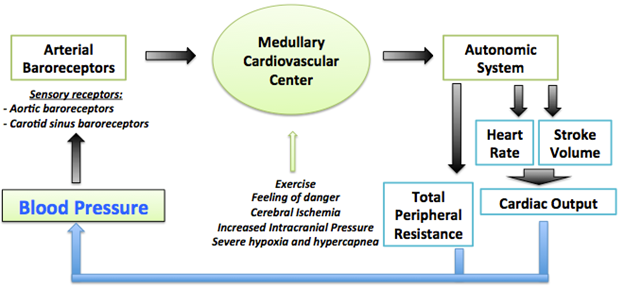In this article, we shall study the origin and measurement of blood pressure.
Origin of Blood Pressure:
Due to the contraction of the heart and by the muscles that surround our blood vessels, blood moves through our circulation system since it is under pressure by it. The measure of this force is blood pressure. In the two main arteries, Blood pressure will always be highest, which is just outside the heart, but since the pulmonary circulation is inaccessible, blood pressure is measured in the systemic circulation only, i.e. blood leaving the left ventricle only normally in the upper arm. Blood pressure is measured by an instrument called the Sphygmomanometer.
Normal systolic pressure is about 120 mm Hg for males; 110mm Hg for females. Average systolic pressure rises with age so (100 + your age) is a safe maximum. Normal diastolic pressure is about 80 mm Hg for males and 70 mm Hg for females. Blood pressure readings are given as two numbers, the systolic (higher) figure over the diastolic (lower) figure e.g. 120/80 mm Hg.
Hypertension (high blood pressure) is diagnosed when the diastolic pressure is >10mm Hg above the normal; the systolic pressure is of less concern.
Measurement of Blood Pressure:
- Ensure the patient is relaxed and has not taken any exercise for at least 10 minutes. A cuff is inflated around a person’s arm – stopping the flow of blood through the artery.
- The pressure in the cuff is slowly released whilst listening for the first sounds of blood passing through the artery. This means that the ventricles are pumping with enough force to overcome the pressure exerted by the cuff. This is the systolic pressure.
- The pressure continues to be released now listening for the disappearance of sound – indicating a steady flow of blood. This is the diastolic pressure when the pressure of the blood is sufficient to keep the arteries open even when the ventricles relax.
Blood Pressure at Different Positions in a Human Body:

Blood pressure in pulmonary arteries is slightly greater than that in capillaries while the blood pressure in pulmonary veins is slightly higher than the veins.
Baroreceptors:
Blood pressure is constantly monitored by the human body and adjusted constantly to meet the needs of the body. This monitoring is performed by baroreceptors. Baroreceptors are special receptors that detect changes in blood pressure. Baroreceptors are found within the walls of blood vessels. The aorta and the carotid sinus contain important baroreceptors which constantly monitor blood pressure fluctuations. These baroreceptors transmit their data to the central nervous system, and more specifically, to the cardio regulatory centre of the medulla oblongata.
Blood Pressure Regulation:

If blood pressure within the aorta or the carotid sinus increases, the walls of these arteries stretch and stimulate increased activity within the baroreceptor. This information is then sent via nerves to the cardio regulatory center within the medulla, which responds by initiating mechanisms that decrease the blood pressure to a normal level.
To lower blood pressure, we first see a decrease of sympathetic input (increase heart rate) and an increase in parasympathetic input (decrease heart rate) to the heart. Therefore, by shutting off the sympathetic stimulation and boosting the parasympathetic stimulation, there is a decrease in the heart rate and stroke volume, which decreases the cardiac output and decreases blood pressure. If the baroreceptors are detecting that blood pressure is too high, the cardio regulatory centre of the medulla will decrease sympathetic input to the blood vessels. This causes vasodilation, which decreases total peripheral resistance and decreases blood pressure.
A decrease in blood pressure causes a decrease in action potentials sent to the cardio regulatory centre of the medulla. Therefore, to raise blood pressure, the body will first cause an increase in sympathetic nerve activity to the SA node, causing it to fire more frequently, which increases the heart rate. The heart muscle is also stimulated to pump with more force, and this increases the stroke volume. When heart rate and stroke volume increase, there is an increase in cardiac output. An increase in cardiac output causes increased blood pressure, restoring blood pressure back to a normal level. This causes an increased sympathetic input to the blood vessels, which stimulates the smooth muscle to contract, causing vasoconstriction, which increases total peripheral resistance and increases blood pressure.